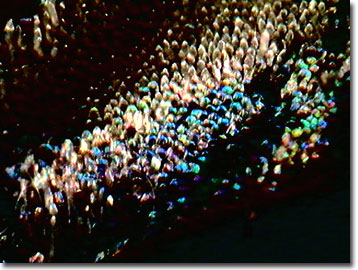Butterfly Wing Scale Digital Image Gallery
Shoemaker Butterfly
A denizen of the Amazonian rainforest, the shoemaker butterfly is a beautiful insect that exhibits deep black wings decorated with contrasting bright orange vertical bands and a large orange spot. Its common name may be an allusion to the fairytale "The Shoemaker and the Elves" and the ancient belief that butterflies were wood nymphs, fairies, or winged elves. The shoemaker moniker may alternatively refer to the shape of the butterfly's wings, which can appear similar to the wooden forms used by a shoemaker to create new shoes.

Scientifically known as Catonephele antinoe, shoemaker butterflies range from Mexico through Central America and into South America. The adults often fly along river courses in the Amazon, frequently stopping to gain nutrients, moisture, and energy from mud puddles and rotten fruit. Considered highly sexually dimorphic as a genus, female shoemaker butterflies lack the bright orange wing patterns featured by the males and, instead, display yellow or cream-colored transverse bands. In fact, while males of the genus Catonephele are distinct for each species, most females of the 11 congeners look alike.
Shoemaker butterfly larvae ingest and incorporate phytochemicals from their food plants into their tissues, which provides a certain amount of defense from predators for the remainder of their lives. Shoemaker caterpillars feed on plants in the family Euphorbiaceae, which contains the spurges and poinsettias, and are especially fond of iporuru and tarweeds. The phytochemicals and alkaloids of iporuru leaves and bark are also useful to humans, who may utilize them as traditional remedies for inflammation, arthritis, and infections. Solitary by nature, larval shoemakers are very spiny and feature a head capsule bearing two prominent metallic blue spines. When at rest, the caterpillars are often observed curled in an S-position on the upper surfaces of host plant leaves.
To help meet the growing demand for mounted specimens and live chrysalides, butterfly farms in South America rear the shoemaker butterfly. The work of the butterfly ranchers and operators of butterfly conservatories is made easier by the simplicity of growing sufficient quantities of the beautiful Costa Rican butterfly vine as an ample supply of larval shoemaker food. However, wild individuals still enter the commercial market and overcollection, coupled with continual encroachment by humans, threatens some Amazon shoemaker populations.
Contributing Authors
Cynthia D. Kelly, Shannon H. Neaves, Laurence D. Zuckerman, and Michael W. Davidson - National High Magnetic Field Laboratory, 1800 East Paul Dirac Dr., The Florida State University, Tallahassee, Florida, 32310.
BACK TO THE BUTTERFLY WING SCALE IMAGE GALLERY
BACK TO THE DIGITAL IMAGE GALLERIES
Questions or comments? Send us an email.
© 1995-2025 by Michael W. Davidson and The Florida State University. All Rights Reserved. No images, graphics, software, scripts, or applets may be reproduced or used in any manner without permission from the copyright holders. Use of this website means you agree to all of the Legal Terms and Conditions set forth by the owners.
This website is maintained by our
Graphics & Web Programming Team
in collaboration with Optical Microscopy at the
National High Magnetic Field Laboratory.
Last Modification Friday, Nov 13, 2015 at 01:19 PM
Access Count Since January 21, 2003: 10142
Visit the website of our partner in introductory microscopy education:
|
|
